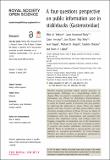Files in this item
A four-questions perspective on public information use in sticklebacks (Gasterosteidae)
Item metadata
| dc.contributor.author | Webster, Michael Munro | |
| dc.contributor.author | Chouinard-Thuly, Laura | |
| dc.contributor.author | Herczeg, Gabor | |
| dc.contributor.author | Kitano, Jun | |
| dc.contributor.author | Riley, Riva Jyoti | |
| dc.contributor.author | Rogers, Sean | |
| dc.contributor.author | Shapiro, Michael D. | |
| dc.contributor.author | Shikano, Takahito | |
| dc.contributor.author | Laland, Kevin N. | |
| dc.date.accessioned | 2019-02-26T12:30:07Z | |
| dc.date.available | 2019-02-26T12:30:07Z | |
| dc.date.issued | 2019-02-20 | |
| dc.identifier | 257368336 | |
| dc.identifier | 69832779-4894-4535-978c-c2002c1a6af7 | |
| dc.identifier | 85062796001 | |
| dc.identifier | 000465432900036 | |
| dc.identifier.citation | Webster , M M , Chouinard-Thuly , L , Herczeg , G , Kitano , J , Riley , R J , Rogers , S , Shapiro , M D , Shikano , T & Laland , K N 2019 , ' A four-questions perspective on public information use in sticklebacks (Gasterosteidae) ' , Royal Society Open Science , vol. 6 , no. 2 , 181735 . https://doi.org/10.1098/rsos.181735 | en |
| dc.identifier.issn | 2054-5703 | |
| dc.identifier.other | ORCID: /0000-0001-9597-6871/work/60427829 | |
| dc.identifier.other | ORCID: /0000-0002-2457-0900/work/60630443 | |
| dc.identifier.uri | https://hdl.handle.net/10023/17155 | |
| dc.description | This research was supported by ERC Advanced (EVOCULTURE 232823) and NERC (NE/D010365/1) grants to KNL and grants from the NSF (IOS0744974, DEB1149160), NIH (R01GM115996), and Burroughs Wellcome Fund to MDS. | en |
| dc.description.abstract | Whether learning primarily reflects general processes or species-specific challenges is a long-standing matter of dispute. Here, we present a comprehensive analysis of public information use (PI-use) in sticklebacks (Gasterosteidae). PI-use is a form of social learning by which animals are able to assess the relative quality of resources, here prey patches, by observing the behaviour of others. PI-use was highly specific with only Pungitius and their closest relative Culaea inconstans showing evidence of PI-use. We saw no effects of ontogenetic experience upon PI-use in Pungitius pungitius. Experiments with live demonstrators and animated fish revealed that heightened activity and feeding strikes by foraging conspecifics are important cues in the transmission of PI. Finally, PI-use was the only form of learning in which P. pungitius and another stickleback, Gasterosteus aculeatus differed. PI-use in sticklebacks is species-specific and may represent an ‘ecological specialization’ for social foraging. Whether this reflects selection on perception, attentional or cognitive processes remains to be determined. | |
| dc.format.extent | 24 | |
| dc.format.extent | 1282880 | |
| dc.language.iso | eng | |
| dc.relation.ispartof | Royal Society Open Science | en |
| dc.subject | Social learning | en |
| dc.subject | Social information | en |
| dc.subject | Foraging | en |
| dc.subject | Cognition | en |
| dc.subject | QH301 Biology | en |
| dc.subject | DAS | en |
| dc.subject.lcc | QH301 | en |
| dc.title | A four-questions perspective on public information use in sticklebacks (Gasterosteidae) | en |
| dc.type | Journal article | en |
| dc.contributor.sponsor | European Research Council | en |
| dc.contributor.sponsor | NERC | en |
| dc.contributor.institution | University of St Andrews. Centre for Biological Diversity | en |
| dc.contributor.institution | University of St Andrews. Centre for Social Learning & Cognitive Evolution | en |
| dc.contributor.institution | University of St Andrews. School of Biology | en |
| dc.contributor.institution | University of St Andrews. Scottish Oceans Institute | en |
| dc.contributor.institution | University of St Andrews. Institute of Behavioural and Neural Sciences | en |
| dc.identifier.doi | https://doi.org/10.1098/rsos.181735 | |
| dc.description.status | Peer reviewed | en |
| dc.identifier.grantnumber | en | |
| dc.identifier.grantnumber | NE/D010365/1 | en |
This item appears in the following Collection(s)
Items in the St Andrews Research Repository are protected by copyright, with all rights reserved, unless otherwise indicated.

